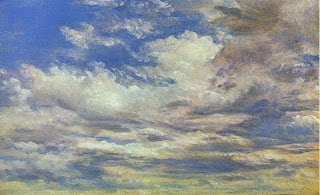Constable, oil on paper,5 Sept 1822
"....ordinary artists have always fallen into one of two faults: either, in rounding the clouds, they make them as solid and hard-edged as a heap of stones tied up in a sack, or they represent them not as rounded at all, but as vague wreaths of mist or flat lights in the sky...."
My own work has tended towards the heap of stones tied up in a sack variety.I am in good company. At least I understood that clouds are three dimensional objects. I do not agree with Ruskin entirely: some clouds appear only as wraith like forms and we cannot really assess their three dimensionality.Not all are like those I saw recently at Craster, where, looking to the south the overlapping layers of cloud streets were lit in a harsh light-tending towards monochrome effects producing chiaroscuro indeed.
The subject of clouds in art is the theme of John Constable's Skies: A Fusion of Art and Science (1999) by John E Thornes who at the time of writing was a professor at Birmingham University.One of its many virtues lies in a meteorologist's expertise about weather,light and the sky.There is a section of historical analysis of the work of great painters who made clouds a feature of their art.This includes artists of the C17 such as Poussin, Claude,Rubens,the Dutchmen,and others such as Giovanni Bellini and Gainsborough.
Thornes has studied the weather records for the time as made by observers such as, most notably, Luke Howard, and made estimates as to how much Constable's sketches tally with what is found in these records .He also looks at the weather records with the aim of helping to date those of Constable's sketches which don't have a complete autograph date. Constable sometimes only gave the day of the month and not the year. Thornes looks at the records and compares them with Constable's own annotations thus attempting, fairly persuasively, to date the undated-a question basically of deciding between 1821 and 1822.
Thornes' criticisms of Constable are very interesting from the scientific point of view. He suggests that the sky in the delightfully fresh Wivenhoe Park seems to rear up behind the landscape. This may be the case but a painting has factors which meteorologists may not appreciate.There is such a thing as the picture plane.In another instance he remarks that the sky in Gainsborough's Mr and Mrs Andrews is suggestive of a smoke from a bonfire, and you can see what he is getting at. Constable and Gainsborough were doing what they could in the circumstances of their time, they were making and matching.
He is not the first to point out that the records in the Constable sketches were not transferred to his major works.So that the changing sky in Landscape : Noon which we know as The Haywain is something which Constable constructed from memory. He wants some meteorological drama and gets it by composing a cloud scene.
I cannot recommend this book highly enough to any artist--or art historian interested in the subject of clouds in general or Constable in particular.

No comments:
Post a Comment